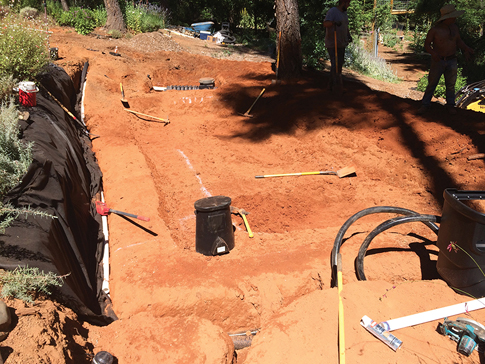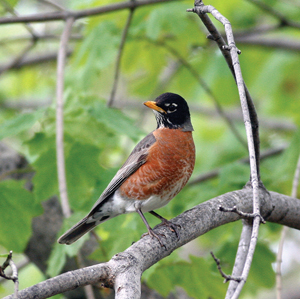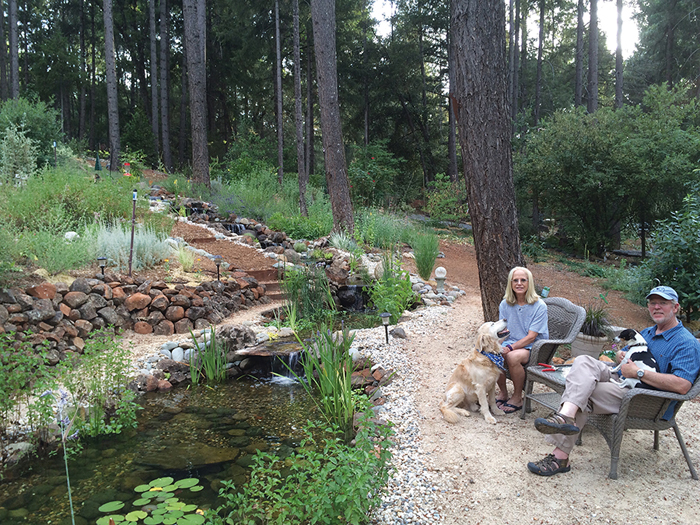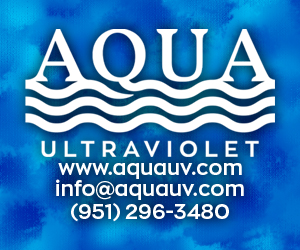What attracts birds to a pond? Moving water, places to bathe and drink, populations of insects to eat and plants for coverage. So when tasked with building a pond specifically for bird-watchers, I implemented all of these elements to create a thriving ecosystem that teems with life — and birds!
Mimicking Mother Nature
In all of my installations I try to mimic Mother Nature. In most cases I am not allowed the freedom to create an environment that supports the surrounding wildlife. But thankfully, on this build the clients wanted a water feature that would cater to their favorite hobby: bird-watching.

Upon my initial consultation, evidence of their love for birds was everywhere. The deck overhanging the clients’ backyard was lined with birdseed and nectar feeders. Beyond that was a native planted garden, all to encourage and invite birds to visit. These clues gave me the initial idea of building a pond with an ecosystem design built around Mother Nature sustaining the environment.
Starting with the base of an ecosystem pond “working with Mother Nature,” the only thing left to do was to create habitats for the insects and crustaceans that the birds eat and an area where the birds could interact with the water. With one of the customers being a master gardener and the other a wildlife biologist, it was a quick reference for me to learn what things I needed to create the best setup to attract the particular birds that they enjoy watching.
One pond plant that I found to attract these creatures is Impatiens. It is a great plant to add to the water’s edge for its attractive power, not to mention the color it provides.
Now that the nectar-seekers were taken care of, I moved onto insect-eaters. In order to attract insects, I needed to create places where they would want to lay their eggs and populate. Insects like the dragonfly and caddisfly would come naturally to the pond in the adult stage, laying their eggs in the water. And with the world’s wetlands diminishing, dragonfly populations are threatened. We created calm areas in the stream and pond to allow the dragonfly to lay her eggs on a plant under the water…or, if she can’t find a plant, to just drop her eggs to the bottom.One unique insect I wanted to attract is the caddisfly. As larvae, caddisflies are “architects” that build their homes around their bodies out of silk, which holds fragments of algae, sticks and gravel to protect them and give them a place to live. After one or two years in this tiny habitat, they metamorphose into adults.
Knowing these things, I implemented a large wetland area with many tall plants and shallows for the dragonflies. We also created stone and pebble areas in the stream and wetland for the caddisflies to live and find their food sources: algae and small plant matter.
A Thriving Ecosystem
 After a year’s passing, this pond is teeming with life. Hummingbirds swoop down to the nearest waterfall to get a drink of water, then speed off to a flower. Birds like the robin and grosbeak eat the bugs by the mouthful and fly off. Not only do the regular bird visitors come to use the pond, but the pond has attracted new varieties of insect-eating birds like the Black Phoebe Flycatcher, which breeds from southwest Oregon and California through Central and South America. It breeds year-round throughout most of its range and migrates less than the other birds in its genus. Another new addition is the Ash-Throated Pacific Flycatcher. This bird is known to wander, with single birds often seen outside their normal breeding range — as far away as the east coast of North America. These two new additions have to travel some distance to the pond since there isn’t another pond nearby.
After a year’s passing, this pond is teeming with life. Hummingbirds swoop down to the nearest waterfall to get a drink of water, then speed off to a flower. Birds like the robin and grosbeak eat the bugs by the mouthful and fly off. Not only do the regular bird visitors come to use the pond, but the pond has attracted new varieties of insect-eating birds like the Black Phoebe Flycatcher, which breeds from southwest Oregon and California through Central and South America. It breeds year-round throughout most of its range and migrates less than the other birds in its genus. Another new addition is the Ash-Throated Pacific Flycatcher. This bird is known to wander, with single birds often seen outside their normal breeding range — as far away as the east coast of North America. These two new additions have to travel some distance to the pond since there isn’t another pond nearby.
Other birds just coming for a drink or a bath land on one of the waterfall stones in slow-moving water to drink and groom themselves.
Birds eat the bugs in the flowing water that bubbles over the river cobbles. Insect-eating birds like robins fly off with mouthfuls of bugs they just caught in the plants. Each waterfall gives many different areas for these different types of birds to use the pond, from the water bubbling over river cobbles for tube-dwelling bugs like the caddisfly to shallow pools of slow-moving water where the birds bathe and drink. It is great to see the excitement of the homeowners watching and listening to the birds as they quiz each other on which bird they just saw.
Beyond Birds
As a bonus, some other visitors that the customers enjoy come to the pond, like the California Tree Frog, the Western Toad and the Sierra Newt. All of these stay in the pools throughout the breeding season and can occasionally be found well into the summer. The eggs from the female are roughly the consistency of a thick gelatin dessert stuck together in strings or masses that adhere to vegetation and other objects along water edges. Larvae hatch sometime in early to mid-summer, depending on local water temperature. Larvae are difficult to find in streams, as they blend in well with the gravel bottom to which they usually stay close.

With California’s drought conditions lingering, this pond has really come together at the right time to support the local wildlife in a time of need. Not only is it a place to drink, but it’s also a place to preserve further populations of animals that depend on water habitats to sustain their populations with offspring and food sources. I can say that watching wild creatures using something I created is one of the most rewarding things I experience in life. As one of the customers said, “Everyone needs a pond.” And so do the wildlife that depend on us to create and preserve ponds for them.



Will only get better with time ☺